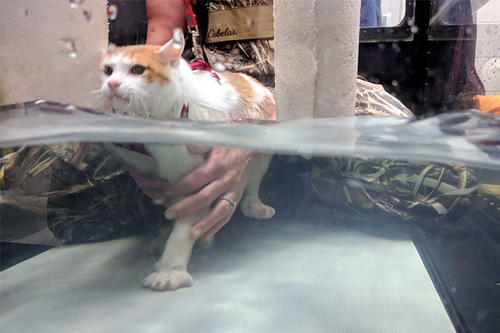
For a cat standing chest-deep in water, Nick didn’t seem too perturbed as Kim Colvard guided his legs along the underwater treadmill. Colvard is a specialist in the Small Animal Rehab department at the University of Minnesota’s Veterinary Medical Center (VMC). In her decade of experience there, she describes Nick’s case as “unique.”
Rehab is rarely considered a viable option for small animals. Felines, especially, are often overlooked as candidates. But small animal rehabilitators like Colvard are working to change this.
Nick arrived at the VMC for a much needed hernia repair. While the surgery went well, Nick’s lungs did not respond in the way they should have, depriving his brain of oxygen for a period of time. The procedure saved his life, yet it left him crippled. Nick’s surgeon recommended him to Colvard and her team. Colvard decided to use teaching funds to cover the cost of the cat’s care and give students the opportunity to learn more about a rare case like Nick’s.
“He came in blind, deaf, and entirely unable to walk,” says Channing Bancroft, a fourth-year College of Veterinary Medicine doctoral student who recently completed a rehab rotation. Bancroft fostered Nick during his treatment, providing at-home care between sessions.
Colvard’s team developed specialized exercises based on Nick’s progress. His feline independence tested their problem-solving skills. Colvard says flexibility is key for any rehab case: “It’s all about thinking on your toes.”
Her team often leveraged Nick’s natural curiosity to keep him engaged, transforming humdrum obstacle courses into intriguing tunnels.
After 10 days of treatment, Nick was walking independently.
“It was really one of the most amazing opportunities that I’ve had in my veterinary career so far,” says Bancroft. “I don’t know of any other veterinary clinic out there who is doing this kind of rehabilitation.”
-------
Companion animal vets account for around 60 percent of the field. In the remaining 40 percent, veterinary medicine contains unexpected roles and applications that, through shaping animal health, actively mold the environment, the economy, and human health. The original version of this story explores the range of veterinary opportunities found within the animal health world.
- Categories:
- Health




